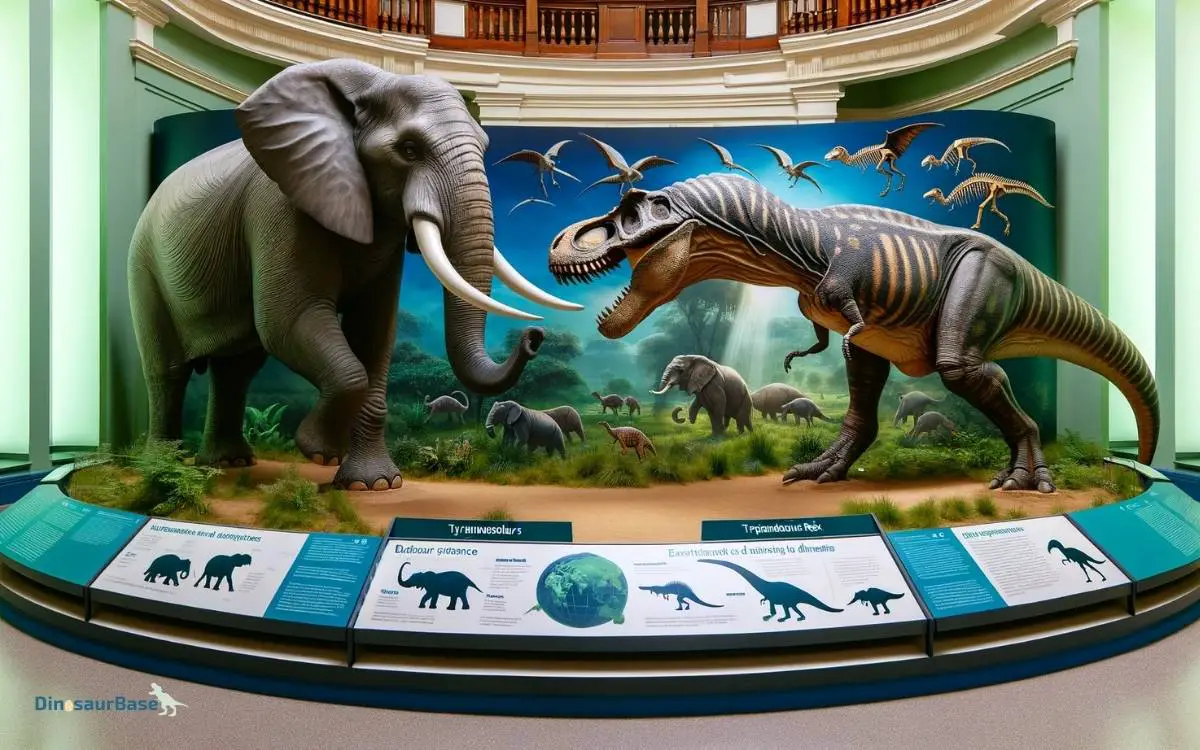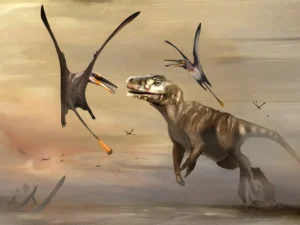How to Understand Elephants’ Place in the Dinosaur Family Tree
Elephants do not belong to the dinosaur family tree. Dinosaurs and elephants are distinct lineages separated by millions of years of evolution.
Understanding the place of elephants within the grand tapestry of life requires a glance back through the annals of evolutionary history.
Elephants are mammals, specifically classified within the Elephantidae family in the order Proboscidea.
This places them far apart from the reptilian dinosaurs, which thrived during the Mesozoic Era before their mass extinction around 65 million years ago.
Elephants evolved much later, arising from a different branch of the animal kingdom entirely. Today’s pachyderms share a more recent ancestor with creatures like the hyrax and manatee than with any dinosaur.
Unraveling the mysteries of these majestic creatures gives us insight into the diversity and complexity of life on Earth.

Elephants And The Dinosaur Family Tree
Among nature’s marvels, elephants stand tall and majestic, often becoming the subject of our imagination when we think of the ancient world of dinosaurs.
Yet, understanding where these giant mammals fit into the dinosaur family tree involves exploring some exciting truths. Let’s unearth these intriguing connections.
Distinguishing Facts From Myths
Common misconceptions can blur our understanding of elephants and their ancestry. Unveiling the accurate narrative is essential.
Here are key points to clarify.
- Elephants are mammals, not descendants of dinosaurs.
- Dinosaurs roamed the Earth millions of years before the first elephants appeared.
- The extinction event that wiped out dinosaurs allowed mammals to evolve and thrive, leading to creatures like the woolly mammoth, and eventually, the elephants we know today.
Chronological Distinctions Between Elephants And Dinosaurs
A clear timeline helps distinguish the eras of these magnificent creatures.
| Time Period | Creature | Notable Events |
|---|---|---|
| 230-65 Million Years Ago | Dinosaurs | Rule the Earth until a mass extinction event. |
| 55 Million Years Ago | Earliest Proboscideans | Ancestors of modern elephants begin to evolve. |
| 5 Million Years Ago | First True Elephants | Evolution leads to species similar to today’s elephants. |
This simplified timeline highlights the distinct epochs that separate dinosaurs and elephants, making it easier to perceive their unique histories on Earth.

Credit: www.nationalgeographic.com
Discovering Prehistoric Connections
Embark on a journey to unravel the mysterious lineage of today’s gentle giants – elephants, and their place within the sprawling dinosaur family tree.
The Evolution Of Mammals
Mammals emerged after the dinosaurs’ reign. Over millions of years, they evolved from tiny creatures into diverse species, including today’s large mammals like elephants. Understand this transition for a glimpse into historical timelines.
- Begin with dinosaur extinction: Learn about the cataclysmic events that led to mammals thriving.
- Evolving traits: Discover how mammals adapted, including fur and warm-blooded systems.
- Login the rise of mammals: Trace the emergence of prehistoric mammals to modern elephants.
Analyzing Fossil Records
Fossils reveal the deep history of species over time. Examining fossils allows us to piece together the relationship between elephants and their ancient relatives.
| Characteristic | Dinosaurs | Elephants |
|---|---|---|
| Time Period | Mesozoic Era | Cenozoic Era |
| Limb Structure | Varied | Columnar |
| Teeth | Sharp/Carnivorous | Flat/Herbivorous |
Examining skeletons and bones: Understand how elephant ancestors’ bones changed over time.
- Study the skulls and tusks for evolutionary clues.
- Compare limb structures to grasp locomotion development.
- Analyze teeth patterns to track diet and habitat adaptation.
Dig deep into the Earth’s layers: Find out how soil sediments preserve prehistoric life records.
Current Scientific Consensus
Understanding elephants’ place in the dinosaur family tree requires exploring ancient history. Dinosaurs and elephants lived millions of years apart.
Elephants are mammals, whereas dinosaurs were reptiles. Modern science confirms that elephants are not descended from dinosaurs.
Expert Opinions On Elephant’s Ancestry
Scientists have studied fossils and DNA to learn about elephant ancestry. They found that elephants have ancient relatives called Proboscidea.
This group is very different from dinosaurs. Elephants evolved long after the last dinosaurs died. Experts agree that elephants are related to other mammals, not dinosaurs.
Misconceptions In Popular Media
Movies and books sometimes show elephants with dinosaurs. This is not accurate. Dinosaurs went extinct about 65 million years ago.
The first elephants appeared around 60 million years later. It’s important to separate fact from fiction. Elephants and dinosaurs never shared the earth together.
Elephants’ Ancestors And Relatives
Welcome to a fascinating journey through time where we uncover the heritage of today’s modern elephants.
Understanding their lineage unveils a story of perseverance, evolution, and some common misconceptions.
Below, we will explore the elephants’ ancestors, how they fit into the broader spectrum of wildlife, and differentiate them from their prehistoric cousins, the mighty dinosaurs.
Common Ancestors Of Modern Elephants
Elephants are revered for their regal stature and complex behaviors. But who are their ancient forefathers? Elephants hail from a diverse group of mammals called Proboscidea.
This family includes not only modern elephants but also their extinct kin. Let’s trace their roots:
- Moeritherium – This small, semi-aquatic creature is a distant relative that roamed the earth about 37 million years ago.
- Mammut – Also known as the American mastodon, it coexisted with early humans and resembled modern elephants in many ways.
- Mammuthus – The iconic woolly mammoths, known for their long curved tusks, are direct ancestors of today’s elephants.
- Palaeomastodon – They are believed to be among the earliest Proboscideans, having a much smaller size compared to the mammoths.
Differentiating Proboscideans From Dinosaurs
Despite their impressive size and ancient existence, elephants are not descendants of dinosaurs. In fact, their ancestors walked the earth millions of years after the dinosaurs went extinct.
Consider these clear distinctions:
| Features | Proboscideans | Dinosaurs |
|---|---|---|
| Time Period | Mostly Cenozoic | Mostly Mesozoic |
| Physiology | Familiar mammalian forms | Varied, including reptilian features |
Proboscideans are a distinct branch of mammals with unique evolutionary paths. The key aspect is mammals flourished after the dinosaur extinction event, approximately 66 million years ago.
This divergence ensures the lineage of elephants and dinosaurs don’t cross within the vast tapestry of life’s timeline.
Role Of Dna In Decoding Relationships
Peering into the mysteries of the past, DNA acts as a time machine. It unveils the links between creatures past and present.
With advances in genetic testing, we now have the power to unravel the lineage of complex beings like elephants.
Their place in the evolutionary hierarchy, specifically in relation to dinosaurs, becomes clearer.
Advances In Genetic Testing
Genetic testing empowers scientists to explore connections that bones alone cannot reveal. Here’s how:
- Extracting ancient DNA from fossils is revolutionary.
- Precise sequencing techniques map out relationships.
- Each discovery brings a clearer evolutionary picture.
Understanding Elephants’ Genetic Inheritance
Elephants are modern marvels with an ancient genetic heritage. Analyzing their DNA sheds light on their place in nature’s tapestry:
- Evidence confirms elephants and dinosaurs had distinct evolutionary paths.
- The closest relatives to elephants today are sea cows and hyraxes.
- Linking DNA patterns to behaviors gives insight into their prehistoric ancestors.

Credit: gwtoday.gwu.edu
Ways To Learn More About Elephants’ History
Curiosity about elephants leads many to question their ancient roots. Did gigantic tuskers roam during the age of dinosaurs?
Understanding the place of elephants in the vast tapestry of life requires exploring their history. Explore museums or dig for fossils to uncover secrets from millions of years ago.
Visiting Natural History Museums
Museums are treasure troves of information. They hold ancient artifacts and detailed displays. Within their walls, you can witness the evolution of elephants.
Skeletons and reconstructions show changes over time. Interactive exhibits often allow for hands-on learning, making the experience memorable and engaging.
- Find your nearest natural history museum.
- Check for elephant exhibits.
- Schedule a visit or join a guided tour.
Most museums feature knowledgeable staff. They can answer your questions. Some even offer special workshops or talks about elephant lineage and prehistoric wildlife.
Participating In Fossil Excavations
Embrace the life of a paleontologist. Joining a dig is thrilling. Local universities or museums might organize excavations. These trips can take you closer to the world elephants inhabited long before humans.
- Research excavation opportunities.
- Prepare for adventure and learning.
- Unearth fossils with experts guiding you.
Discovering a fragment of elephant history is possible. It brings a sense of connection to these creatures. It shows their journey through time.
Frequently Asked Questions On How To Understand Elephants’ Place In The Dinosaur Family Tree
How Closely Related Are Elephants To Dinosaurs?
Elephants and dinosaurs are not directly related. Elephants are mammals, while dinosaurs were reptiles from a separate evolutionary lineage. The two groups share a distant common ancestor but diverged millions of years ago.
Were Elephants In The Dinosaur Era?
Elephants were not present during the dinosaur era. They evolved millions of years later, after the extinction of dinosaurs.
What Is The Order Of Elephant In Taxonomy?
Elephants belong to the order Proboscidea in the taxonomic classification system. This order groups elephants with their closest extinct relatives.
What Is The Lineage Of The Elephant?
Elephants belong to the family Elephantidae, within the order Proboscidea. This family includes three living species: African bush elephant, African forest elephant, and the Asian elephant.
Conclusion
Understanding elephants’ evolutionary journey illuminates their absence from the dinosaur lineage. It reveals a distinct path separate from those ancient titans.
Appreciate elephants for their unique place in nature’s tapestry, carving out an ecological niche post-dinosaur era. Remember, their history is rich with lessons for today’s conservation efforts.
Embrace their story and ensure their survival.



